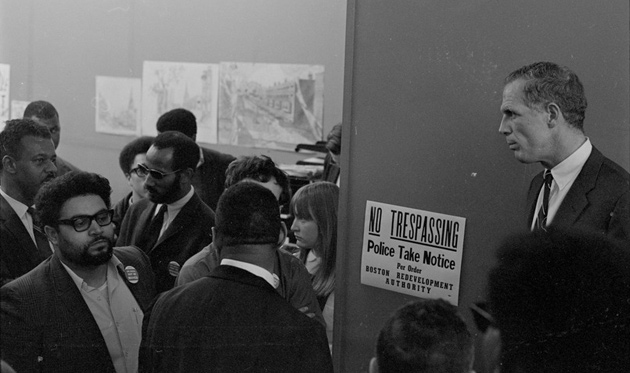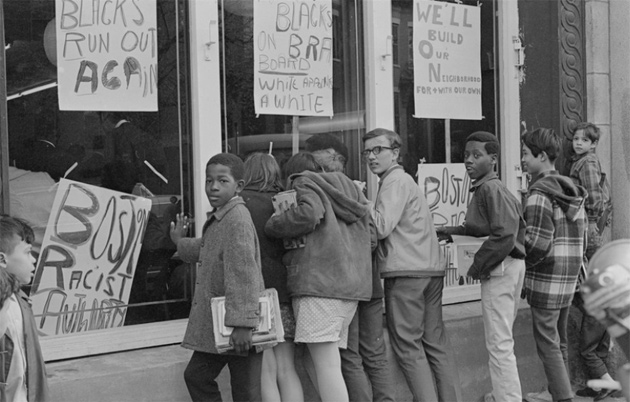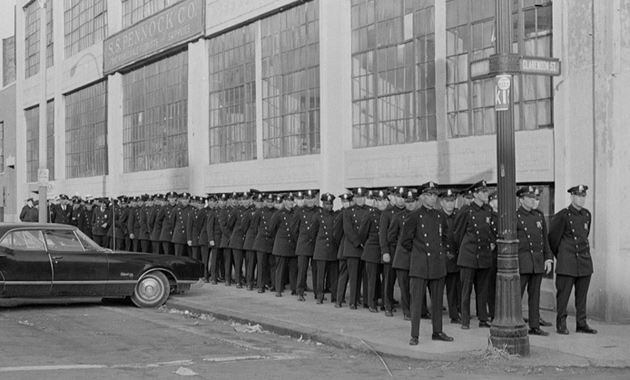South End gentrification, then and now

On April 25, 1968, South End residents held a sit-in at what was then a Boston Redevelopment Authority office in an old fire house on Warren Avenue in the South End, to protest the authority's large-scale South End urban-renewal plans that would force thousands of residents to move.
The former fire house (on the right) and the neighboring building with one of the area's wholesale florists, remain to this day, now as condos:
In the early 1960s, the BRA designated pretty much the entire South End as an "urban renewal" district and planned to buy up property - and move out up "1,730 families and 1,820 single person households" - to eliminate what the BRA called "severe conditions of blight, deterioration, obsolescence, traffic congestion and incompatible land uses" to create a nirvana of "neighborhood, industrial, commercial and institutional stability."
But as in the even more completely urban-renewed West End, people actually lived in the South End. And on the morning of April 25, the Community Assembly for a United South End took over the office the BRA had set up to handle relocation of South End residents and businesses, to protest the way all the new construction would displace the neighborhood's residents in favor of people with a lot more disposable income.
By 2 p.m., Mayor White had had enough and drove over from City Hall to try to get the protesters to leave. But as the Evening Globe reported:
A burly protester, identified as John Marshall, president of CAUSE (Community Assembly for a United South End) blocked the mayor from entering the office area. He never got beyond the lobby.
"This is city property, I'm going through," White said in strong tones.
"This is public power," Marshall retorted.
White looks out over protesters (source):

After school let out at the McKay, students peered inside (source):

Cops lined up in case of trouble that never came (source):

The protesters finally left in the evening, perhaps winning a battle: The South End was not bulldozed the way the West End was, and many of the buildings planned for demolition were instead rehabbed.
But with a few exceptions, such as Villa Victoria and the Cathedral housing development, the South End today is the epitome of an upper-income Boston neighborhood.
Photos from the BPL Brearley collection posted under this Creative Commons license.
Ad:

Comments
What would people think
If Boston was to propose a similar widespread demolition of the South End to build large multi unit buildings with the goal of reducing pressure on the housing stock.
Block by block, replace 50 existing condos and apartments with larger 500 unit buildings. It would be a lot of mostly wealthy and/or long time residents tossed out but far more people would have a chance to live in the city.
Follow up question: In 75 years would people be mourning the loss of the old South End if this occured?
I'd think they didn't care about tax revenue
Since all those million-dollar-plus condos are funding a big chunk of the city budget. Keeping property scarce ("pressure on the housing stock") keeps property values high and maintains the tax base.
I'm not even sure they could build at a price point that would be considered "affordable" and the cost of condemning the properties would be very high since the wealthy folks can afford lawyers and would have the city's own property assessments to back them up on valuation.
Since most of the South End is a protected landmark district (and has been for 40 years) one presumes it might be missed in future, although perhaps not for the retail and restaurants.
FWIW the preservation of the South End likely helped lead to its gentrification once the city became less undesirable. It just needed to become cheap enough for the gays to want to start moving in and fixing up all those old neglected brownstones.
Yes I think they would,
Yes I think they would, largely because the South End is built in such a human-scaled way with traditional architecture that is rarely repeated or achieved with today's construction.
While I do think that we should be replacing low-rise buildings with larger ones, I think there are plenty of places in and around Boston with much less historical architectural significance than most of the buildings that currently remain in the South End (particularly buildings built in the late 1800s and early 1900s.)
First, I would suggest replacing single story retail with ground floor retail with housing above, replacing single story industrial buildings with multi-story residential and mixed use, and even replacing unremarkable triple deckers with larger buildings before we start to even consider touching older buildings in older neighborhoods such as the South End, Back Bay, Beacon Hill, etc.
These older buildings that have been here for hundreds of years are a large part of what makes Boston so unique and special. While we do indeed have a housing shortage, I think we have enough places to build that we don't have to sacrifice the older buildings.
Musing or suggestion?
I don't understand your question completely but I find it intriguing nonetheless.
Taking people's private property isn't something that governments typically do, in the United States.
The situation in the 1960s (and into the 1970s) was such that land-taking seemed the only solution to those "in power".
They had an easier time of it because many of the buildings that were demolished where owned by small-time, out-of-town investors who had no desire to fight City Hall and preferred to receive a check when their properties were taken through eminent domain. Many buildings were empty and the owners were just paying property taxes - or not. The owners took their money and ran.
Today, most buildings in the South End are made up of individual condominiums with many different owners. You wouldn't get many to agree to giving up their homes without a fight.
So it's not worth it.
The South End has plenty of private moderate-sized housing developments, now, specifically in the New York Streets area. For the rest of the neighborhood, the housing stock is in good shape and is being actively used (and enjoyed) by owner-occupants.
So the same situation doesn't exist as it did in mid-20th century Boston.
There is plenty of fallow land in Boston on which to build dense housing, including in the South End, so there's no need to destroy what's already there.
Re: your question about "would we still be talking about this 50 years from now if we tore it all down now", no, we wouldn't, and it's valid to consider whether or not we should be talking at length at what happened in Boston 50 years ago in the past. It happened and now it's over with.
Lessons can be learned but times are different and there's very little today that relates in any way to what was happening then.
BRA and BPDA
had done more damage to the City by pushing residents out, destroying historic buildings and turning real neighborhoods upside down. Boston no longer has any character of its old self unlike other New England large cities.
1975
I had dinner at Aquitaine last night. One of the people we were with was from out of country. She loved the neighborhood and I explained to her that this building up until the mid-80's had been abandoned for years. I told her the two busiest businesses in the area in the early 90's were the two packies between Clarendon and Dartmouth along Tremont. One, where there was no self service.
I walked into the DeLux and nothing much has changed except the bartenders were in kindergarten when I used to go there off and on. That's good.
I walked back to my car and lamented that Laskers is gone, Glick Florist is gone and the laundry where my wife used to clean her clothes is now a high end butcher shop.
However, Give credit to these protesters.
I had family come from Australia in 1975. They had heard about "the ghetto" on tv and wanted to see it. My dad took them to the corner of Clarendon and Tremont. Think about that compared to what it is now. There was a lot of empty real estate. Washington Street between the Cath. High and East Berkeley was almost out of The Road, even up until the early 90's.
Fair play to these people to stand up to the BRA. After the Dresending of the West End, I would have too stood up to the city. The coolest kids in my high school mostly came from the South End. Stopping the BRA allowed a lot of creative people to flourish and then in turn make gobs of money selling the neighborhood into the sanitized stroller palace that it is now. That's the rub though.
Nevertheless, I'd rather have the largest Victorian row house area in America preserved over making the area another West End, despite the ridiculous rents.
One thing about Villa Victoria. That section of the South End had a mixture of schools, wood frame residences, and some old, small commercial buildings. It had a different construction type than say Pembroke Street. It wasn't all residential, which made removal easier.
Villa Victoria area
If you want to see what those buildings looked like before Villa Victoria, look for Haven St., just off of Shawmut Ave.
Villa Victoria
in an effort to figure out where this was... I found this neat gem about the development and how it came to be
https://archive.revista.drclas.harvard.edu/book/creation-villa-victoria
But it's simple
A neighborhood is like a shark. It dies if it doesn't move forward.
The South End was a dead shark.
Of course, it's more complicated than that
I had never heard of this protest. Very interesting
I disagree
The South End was not dead. It was a Puerto Rican and LGBTQ+ (did I get that right?) stronghold. So basically low income: Landlords were not happy. Things had to change. They did.
Tent City
Was this related to the protests that led to Tent City?
Still, for newbies ..
"But with a few exceptions, such as Villa Victoria and the Cathedral housing development, the South End today is the epitome of an upper-income Boston neighborhood."
As always, it's important (to me) to point out that, as a percentage, the South End has more income-restricted housing than any other Boston neighborhood except for Roxbury and Chinatown.
https://www.boston.gov/sites/default/files/file/2022/04/Income%20Restric...
The problem (to me) is that low-income residents were "warehoused" instead of remaining members of their community.
The South End is such an amazing story that it deserves as much attention as it can get.
Parking Is Different Too
You have a much better chance of having your own parking space if you live in a Resident Owned Co-op such as Methunion Mannor or Castle Square than you do owing a $1.5M unit on Hanson Street.
Just to say the quiet part out loud…
The South End has housing for the rich. The South End has housing for the poor. The south End does not have housing for the middle class.